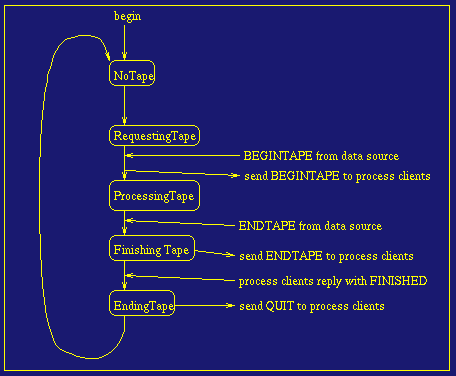
The E852 Event Dispatcher is a robust and versatile system for distributed data analysis.
The basic units of data handled by the dispatcher are raw data events and analyzed (processed) data events. The Dispatcher receives raw data events from a data source (a tape reading program, a data acquisition program, a monte carlo generator, etc...), sends them to multiple identical analyzers (process clients), receives analyzed data back and sends it to various display clients.

The Dispatcher name is hostname:port, where hostname
is the host name of the machine running the Dispatcher and port
is the Dispatcher TCP port.
Currently allocated TCP ports are:
10002 - E881 offline analysis 10099 - E852 offline analysis 10098 - E852 online system
The Dispatcher has a number of internal states:
NoTape - no data is being processed
RequestingTape - waiting for 'BEGINTAPE' from the data source.
ProcessingTape - data is being processed.
FinishingTape - the data source sent an 'ENDTAPE' but there is still buffered non-analyzed data.
EndingTape - data processing is finished, the Dispatcher is waiting for the process clients to 'FINISH'.
The Dispatcher changes his states in responses to various commands sent to him. The figure below and a more verbose discussion of the Dispatcher-analyzer protocol after it document the behaviour of the Dispatcher.

Before data can be analysed, the Data source, Dispatcher and analysers have to agree on what they are doing.
To acheive agreement, they send each other various messages (called commands) using
the disIO_command() function.
The expected sequence of events follows:
REQUEST_DATA command and wait.
REQUEST_DATA messages and registers their senders as process clients
BEGINTAPE command.
BEGINTAPE and sends BEGINTAPE:nnn commands
to the process clients, where nnn is the 'client number'.
BEGINTAPE:nnn and perform any necessary initialization.
The client number nnn allows (for example) one of the analysers to identify himself
as a 'master analyser'.
BEGINTAPE, the data source starts sending raw data.
ENDTAPE command.
ENDTAPE, it waits until the raw data buffered
inside the Dispatcher is analysed and sends ENDTAPE messages to all the process clients.
ENDTAPE commands from the Dispatcher, they perform any necessary
cleanup/shutdown work and send back the FINISHED command.
FINISHED. After all the process
clients reply, the Dispather sends them the QUIT command and disconnects them. At this point
the data analysis cycle is finished. If more data is to be analysed, the analysers might reconnect
to the Dispacther, a new data source can be started and everything starts anew.
BROADCAST:dest:command - the analyzer sends the command
to clients specified by dest, which can be one of-...
PWD - print current working directory (getcwd())
DIRECTORY:itapedir set the itape directory (default is './itape')
DIRECTORY print the value of the itape directory
HOST:str set the value of the Dispatcher 'HostComputer' variable to 'str'
DEBUG:0 turn debug mode 0 on.
DEBUG:1 turn debug mode 1 on.
NODEBUG:0 turn debug mode 0 off.
NODEBUG:1 turn debug mode 1 off.
CLOSE:DATA close the data source connection
CLOSE:socket close the given socket
DROP:socket close the given socket
QUIT close the sender's socket
QUIT_DISPLAY close the sender's socket
DUMP print the Dispatcher's internal tables, states, queues, buffers, etc...
NOP ignored
STATISTICS print a number of accumulated statistics
login - [A->DIS] the sender identifies himself as a process client
BEGINTAPE:clientNo:runNo - [DIS->A] sent by the Dispatcher when he receives a 'BEGINTAPE' from the data source.
REQUEST_DATA - [A->DIS] request raw data.
ENDTAPE - [DIS->A] sent by the Dispatcher when he receives an 'ENDTAPE' from the data source.
FINISHED - [A->DIS] sent to the Dispatcher in reply to the 'ENDTAPE' message
QUIT - [DIS->A] sent by the Dispatcher when he wants the analyzer to terminate.
BEGINTAPE[:runNo] - [R->DIS]
ENDTAPE - [R->DIS]
Display:triggerMask:latchMask - [D->DIS] the sender is registered as a display client interested
in events with triggers specified by 'triggerMask' and latch value specified by 'latchMask'.
If either mask is absent, it is taken to be '0xffffffff'.
REQUEST_DISPLAY - [D->DIS] request analyzed data.
The default behaviour of the Dispatcher is data neutral. This means that he does not try to interpret the data being dispatched.
When given the -e852 switch, some additional, experiment dependant
processing is allowed. Currently, only special treatment of begin-of-spill (BOS) and end-of-spill (EOS)
events is involved, by more can be added later.
The structure of the E852 data is such that some vital information (such as beam line (Dibbuk) or MPS magnet probe data) is recorded only once per spill in the BOS and EOS events. Therefore these events are to be passed to every analyzer, unlike regular events, which sent to one and only one analyzer.
//CO 17 Apr 1994